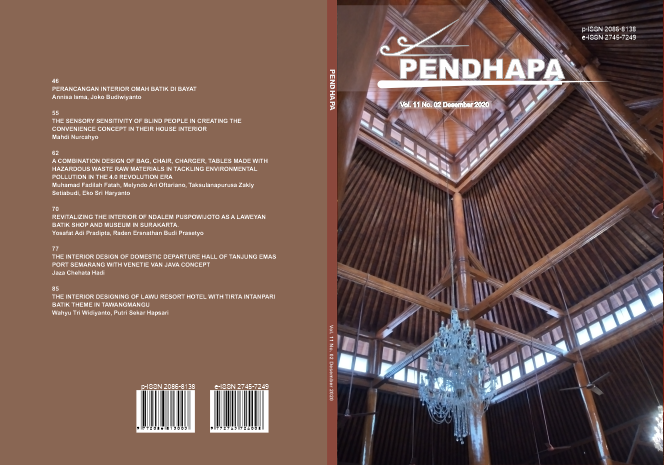A Combination Design of Bag, Chair, Charger, Tables Made with Hazardous Waste Raw Materials in Tackling Environmental Pollution in the 4.0 Revolution Era
DOI:
https://doi.org/10.33153/pendhapa.v11i2.3614Keywords:
multifunction design, inovasition, environmentAbstract
The design of bags, chairs, chargers and tables is intended for commuter workers who carry out mobility activities every day. Design works that help to support commuter worker activities use a multi-functional system. The multi-function system is indicate by the shape and features attached. This product design method uses several stages including; 1) problem identification; 2) literature study: 3) design sketches, and: 4) design. The design results are turned into chairs, tables for lesehan (sitting on the floor) and bags. In addition, the other things are the storage box to store equipments for commuter workers while doing mobility and a solar cell which functions to capture sunlight which will be converted into electrical energy for energy sources to charge cellphones. Design works can be used in accordance with their respective functions. Design works carry the principle of multifunction, easy use, strong, lightweight and flexible. It is hoped that the design for this multi-functional products can be practical in use in the development of creative industries, and can overcome environmental pollution problems. From a theoretical perspective, it can be a reference for academics and science.
Downloads
References
Andansari, Dita, and Nadya Aglisyifa. 2020. “DESAIN MEJA TAMU.” Jurnal Kreatif : Desain Produk Industri Dan Arsitektur 6 (1). https://doi.org/10.46964/jkdpia.v6i1.35.
Gardner, Benjamin, Stuart Flint, Amanda L. Rebar, Stephen Dewitt, Sahana K. Quail, Helen Whall, and Lee Smith. 2019. “Is Sitting Invisible? Exploring How People Mentally Represent Sitting.” International Journal of Behavioral Nutrition and Physical Activity 16 (1). https://doi.org/10.1186/s12966-019-0851-0.
Indah, Febriamitha, Bambang Susantono, and Bambang Riyanto. 2015. “Analisis Tingkat Pelayanan Transportasi Berkesinambungan (Seamless Service) (Studi Kasus: Perjalanan Komuter Jabodetabek Melalui Stasiun Kereta Api Bekasi).” JURNAL PEMBANGUNAN WILAYAH & KOTA 11 (3). https://doi.org/10.14710/pwk.v11i3.10856.
Joseph De Chiara, Julius Panero, and Martin Zelnik. 1992. Time Saver Standards for Interior Design and Space Planning. New York: Mc Graw Hill.
Kusyanto. 2013. “Herry Koesyanto.” KESMAS - Jurnal Kesehatan Masyarakat 9 (1).
Mauluddhina, Ika. 2019. “Eksekusi Putusan Tindak Pidana Lingkungan Hidup Terkait Limbah Bahan Berbahaya Beracun (B3).” Media Iuris 2 (1). https://doi.org/10.20473/mi.v2i1.11358.
Olofsson, Erik, and Klara Sjolen. 2006. Design Sketching.Pdf. 2nd ed. Klippan, Sweden: KEEOS Design Book.
Poetra, Burhan Leonardi. 2016. “Perancangan Perabot Multifungsi Untuk Ruang Huni Terbatas.” Intra 4 (2).
Prayitno, Gunarwan, and Emilia Roza. 2018. “Analisa Matematik Karakteristik Detector Semikonduktor Silicon Tipe P Sebagai Bahan Detector Partikel Radiasi Bermuatan.” Prosiding Seminar Nasional Teknoka 3. https://doi.org/10.22236/teknoka.v3i0.2822.
Rizkinaswara, Leski. 2020. “Revolusi Industri 4.0.” Infrastruktur TIK, no. 28 January.
Setyanto, Ignatius Chandra, and Yulinah Trihadiningrum. 2017. “Kajian Pengelolaan Limbah Elektronik Di Unit Pendidikan ITS.” Jurnal Teknik ITS 6 (2). https://doi.org/10.12962/j23373539.v6i2.25320.
Suhartini. 2020. “Pengembangan Produk Meja Belajar Multifungsi Dengan Menggunakan Metode Quality Function Deployment Dan Antropometri.” Jurnal Tecnoscienza 4 (2).
Sumarno. 2015. “Cakruk as Local Wisdom and Reflection of Ancient Javanese Architecture in Indonesian.” Art and Design Studies 34 (0): 27–35. http://iiste.org/Journals/index.php/ADS/article/view/24594.
Sumarno, Dharsono, Guntur, Agung Purnomo, and Bagus Setyawan. 2019. “Rattan Batik: Local Wisdom-Based Rattan Furnitures Finishing Industry.” In SEWORD FRESSH 2019. EAI. https://doi.org/10.4108/eai.27-4-2019.2286919.
Downloads
Published
Issue
Section
License
Authors who publish with Pendhapa agree to the following terms:
- Authors retain copyright and grant the journal right of first publication with the work simultaneously licensed under a Creative Commons Attribution License (CC BY-SA 4.0) that allows others to share the work with an acknowledgment of the work's authorship and initial publication in this journal.
- Authors are able to enter into separate, additional contractual arrangements for the non-exclusive distribution of the journal's published version of the work (e.g., post it to an institutional repository or publish it in a book), with an acknowledgment of its initial publication in this journal.
- Authors are permitted and encouraged to post their work online (e.g., in institutional repositories or on their website) prior to and during the submission process, as it can lead to productive exchanges, as well as earlier and greater citation of published work.

This work is licensed under a Creative Commons Attribution-ShareAlike 4.0 International License.









